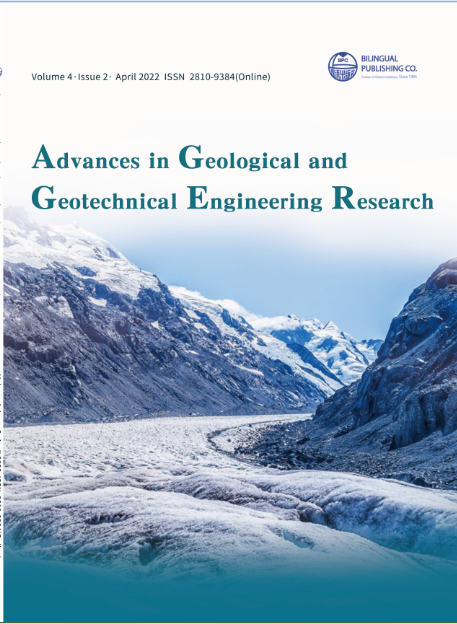-
855
-
691
-
560
-
535
-
485
A Typical Sublithospheric Mantle beneath the Tello Region, SE-Ngaoundéré (Cameroon Line)
DOI:
https://doi.org/10.30564/agger.v4i2.4580Abstract
Peridotite xenoliths, raised to the surface by alkaline basalts or kimberlites,provide us direct information on the processes and composition of the upper mantle. They are the major source of information on the state of stress,pressure and temperature in the deep mantle. They are thus a source of petrological and geochemical information that is generally not available on the Earth’s surface. Fresh spinel-lherzolite xenoliths exhibit a protogranular components of the Tello volcano. The Tello is the continental sector of the Cameroon Line, located in the South East of the town of Ngaoundéré at 75 km approximately between (N7° 13’, N7° 14’) and (E13° 40’ and E13° 60’). Minerals’ composition of the xenoliths is ~64% olivine, ~24% orthopyroxene, ~11% clinopyroxene and ~1% spinel. Significant variation in (Cr/Cr + Al) of the system shows the reciprocal nature of the spinel solution.The Tello spinel lherzolites show internal chemical homogeneity and represent a normal upper mantle. Their mineral chemistries suggest equilibrium condition of 830° - 925° and 1.4 GPa-2.3 GPa. These data suggest that there is good correlation bracket between increasing activity of Al2O3 and decreasing of practionning of TiO2 into spinel. The AlIV and AlVI contents vary by 0.05-0.2 and 0.03-0.2 respectively. The majority of samples caracterise the lithospheric mantle.
Keywords:
Spinel-Lherzolite xenoliths, Protogranular, Sublithospheric mantle, Tello, Cameroon lineReferences
[1] Déruelle, B., Ngounouno, I., Demaiffe, D., 2007 The “Cameroon Hot Line” (CHL): A unique example of active alkaline intraplate structure in both oceanic and continental lithospheres. C.R. Geos. 339, 589-600.
[2] Kamgang, P., 2003. Pétrologie et géochimie d’un secteur clé de la Ligne du Cameroun, les monts Bamenda:Implications sur la genèse et l’évolution des magmas.Thèse Doct. D’Etatn Univ. Ydé. I. pp. 373.
[3] Fitton, J.G., Dunlop, H.M., 1985. The Cameroon line, West Africa, and its bearing on the origin of oceanic and continental alcali basalt. Earth Planet Sci let. 72, 23-38.
[4] Tchoua, M.F., 1974. Contribution à l’étude géologique et pétrologique de quelques volcans de la Ligne du Cameroun (Monts Manengouba et Bambouto). Thèse Doct. d’Etat. Univ. Clérmont-Ferrand. pp. 337.
[5] Dumont, J.F., Toteu, S.F., 1984. Sur deux cycles de migmatisation dans la zone mobile panafricaine, au Nord Cameroun, 10 R.A.S.T., Bordeaux.
[6] Tchameni, R., Pouclet, A., Penaye, J., et al., 2006.Petrography and Geochemistry of the Ngaoundéré Pan-African Granitoids in Central North Cameroon:Implications for Their Sources and Geological Setting. Journal of African Earth Sciences. 44, 511-529.DOI: http://dx.doi.org/10.1016/j.jafrearsci.2005.11.017
[7] Le Maréchal, A., 1976. Géologie et géochimie des sources thermo-minérales du Cameroun.Travaux et documents ORSTROM, Paris. 59, 1-175.
[8] Mercier, J.C., Nicolas, A., 1975. Textures and fabrics of upper mantle peridotites as illustrated by xenoliths from basalts. Jour Petrol. 16, 454-487.
[9] Kretz, R., 1983. Symbols for rock-forming minerals.Amer Miner. 68, 277-279.
[10] Morimoto, N., 1989. Nomenclature of Pyroxenes.Canadian Mineralogist. 27, 143-154.
[11] Dal Negro, A., Carbonin, S., Domeneghetti, C., et al.,1984. Crystal Chemistry and Evolution of the Clinopyroxene in a Suite of High Pressure Ultramafic Nodules from the Newer Volcanics of Victoria. Australia. Contributions to Mineralogy and Petrology.86, 221-229.
[12] Nasir, S., A1-Fuqha, H., 1988. Spinel-Lherzolite Xenoliths from the Aritain Volcano. NE-Jordan.
[13] Dautria, J.M., Girod, M., 1986. Les enclaves de lherzolite à spinelle et plagioclase du volcan de Dibi (Adamaoua, Cameroun): des témoins du manteau anormal. Bulletin De Mineralogie. 109, 275-286.
[14] Jankovics, É., Dobosi, G., Embey-Isztin, A., et al.,2013. Origin and ascent history of unusually crystal-rich alkaline basaltic magmas from the western Pannonian Basin. Bulletin Volcanol. 75(749), 1-23.
[15] Matsui, Y., Nishizawa, O., 1974. Iron (II) - magnesium exchange equilibrium between olivine and calcium-free over a temperature range 800°C to 1300°C.Bulletin de la Société française de Minéralogie et de Cristallographie. 97, 122-130.
[16] Green, D.H., Hibberson, W., 1970. The Instability of Plagioclase in Peridotite at High Pressure.Lithos. 3,209-221.DOI: http://dx.doi.org/10.1016/0024-4937(70)90074-5
[17] Gasparik, T., 1987. Orthopyroxene Thermobarometry in Simple and Complex Systems.Contributions to Mineralogy and Petrology. 96, 357-370.DOI: http://dx.doi.org/10.1007/BF00371254
[18] O’reilly, S.Y., Chen, D., Griffin, W., et al., 1997.Minor Elements in Olivine from Spinel Lherzolite Xenoliths: Implications for Thermobarometry. Mineralogical Magazine. 61, 257-269.DOI: http://dx.doi.org/10.1180/minmag.1997.061.405.09
[19] Zindler, A., Hart, S.R., 1986. Chemical geodynamics.Annual Review of Earth and Planetary Sciences. 14, 493-571.
[20] Bertrand, P., Sotin, C., Gaulier, J.M., et al., 1987. La solubilité de l’aluminium dans l’orthopyroxène globale des données expérimentales du systeme MgO-Al2O3-SiO2. Bulletin de la Societé Géologique de France. 8, 821-832.
[21] O’neill, H.S.C., 1981. The Transition between Spinel Lherzolite and Garnet Lherzolite.
[22] Clark Jr., S.J., Ringwood, A.E., 1964. Density Distribution and Constitution of the Mantle. Reviews of Geophysics. 2, 35-88.DOI: http://dx.doi.org/10.1029/RG002i001p00035
[23] Lee, D.C., Halliday, A.N., Davies, G.R., et al., 1996. Melt Enrichment of Shallow Depleted Mantle: A Detailed Petrological. Trace Element and Isotopic Study of Mantle-Derived Xenoliths and Megacrysts from the Cameroon Line. Journal of Petrology. 37, 415-441.DOI: http://dx.doi.org/10.1016/j.crte.2007.10.012
[24] Green, D.H., Ringwood, A.E., 1967. The Genesis of Basaltic Magmas. Contributions to Mineralogy and Petrology. 15, 103-190.DOI: http://dx.doi.org/10.1007/BF00372052
[25] Mysen, B.O., Kushiro, I., 1977. Compositional Variations of Coexisting Phases with Degrees of Melting of Peridotte in the Upper Mantle. American Mineralogist. 62, 843-865.
[26] Nkouandou, O.F., Temdjim, R., 2011. Petrology of Spinel Lherzolite Xenoliths and Host Basaltic Lava from Ngao Voglar Volcano. Adamawa Massif (Cameroon Volcanic Line. West Africa): Equilibrium Conditions and Mantle Characteristics. Journal of Geosciences. 56, 375-387.
Downloads
How to Cite
Issue
Article Type
License
Copyright © 2022 Nguihdama Dagwai, Kamgang Pierre, Mbowou Gbambié Isaac Bertrand, Chazot Gilles, Ngounouno Ismaïla

This is an open access article under the Creative Commons Attribution-NonCommercial 4.0 International (CC BY-NC 4.0) License.




 Nguihdama Dagwai
Nguihdama Dagwai





